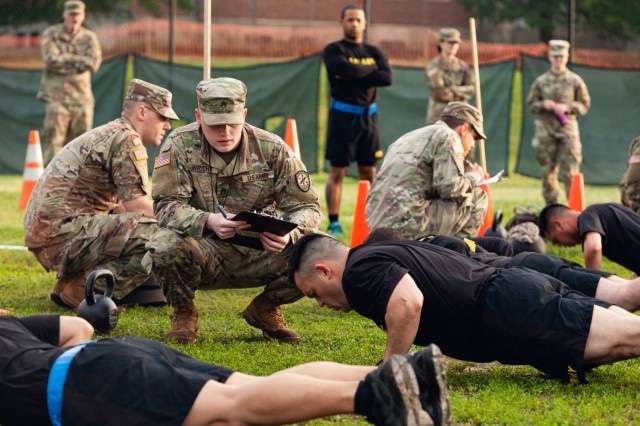
WASHINGTON – Secretary of the Army Christine E. Wormuth issued an Army Directive today outlining a time-phased implementation of a revised ACFT as the Army’s general physical fitness test.
Changes made to the ACFT incorporate feedback from Soldiers and independent analysis of test performance.
Among the key changes announced by the Army are new age-and-gender-performance normed scoring scales; the replacement of the leg tuck with the plank for the core-strength assessment; and the addition of the 2.5-mile walk as an alternate aerobic event.
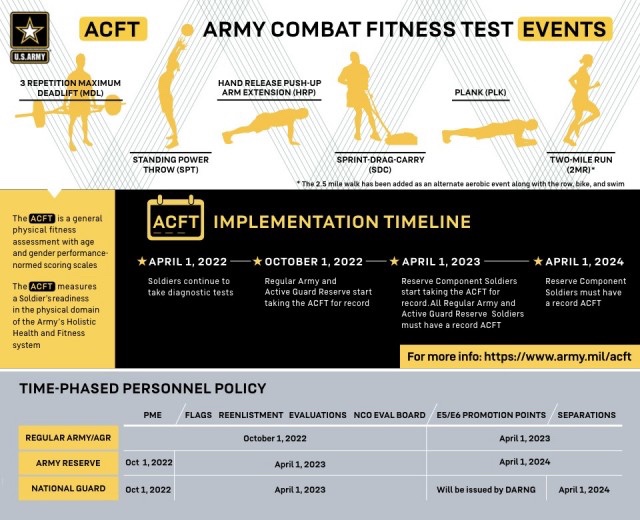
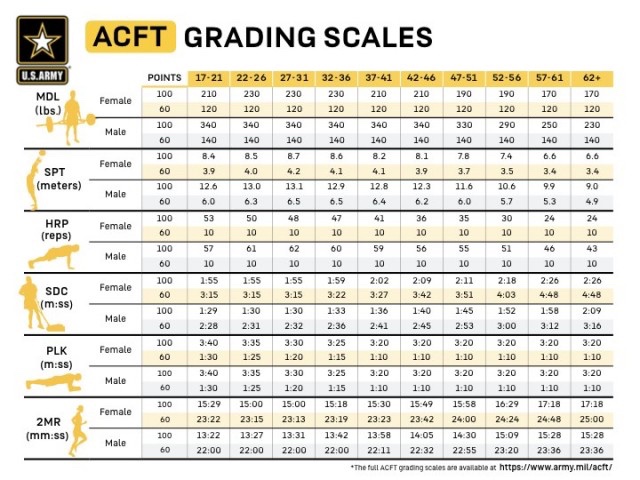
“The ACFT is an essential part of maintaining the readiness of the Army as we transform into the Army of 2030,” Wormuth said.
“The revisions to the ACFT are based on data and analysis, including an independent assessment required by Congress. We will continue to assess our implementation of the test to ensure it is fair and achieves our goal of strengthening the Army’s fitness culture.”
A common concern identified by the Army’s independent analysis and the RAND study was that a gender-neutral test might not accurately measure all Soldiers’ general physical fitness levels. One example was using the leg tuck as the assessment of core strength.
RAND concluded that Soldiers might have the core strength that is not accurately measured if they lack the upper body strength required to perform a leg tuck. Now, the plank will be the sole exercise to assess core strength, using recognized standards from sister services as a baseline, and modifying the scales based on Army requirements.
The revised ACFT will utilize scoring scales that are age and gender normed, similar to the APFT. The Army designed the new scoring scales from nearly 630,000 ACFT performance scores, historical performance rates from the APFT, and scoring scales used by other military services.
The Army will continue to assess performance data and has established an ACFT governance body to provide oversight of the full implementation of the new test. This structure will assess ACFT scores, pass rates, injuries and environmental considerations, and report those findings along with any recommended changes to Army Senior Leaders. The first comprehensive assessment will be in April 2023.
Unlike the APFT, which went largely unchanged for 40 years, Army leaders believe the ACFT must be adaptable.
“Since 2018 we’ve said this test would evolve, and it has,” said Sgt. Maj. of the Army Michael Grinston.
Grinston noted the governance structure will continue to advance the ACFT to maximize the physical fitness of the force.
The six-event ACFT now provides commanders and Soldiers an accurate assessment of a Soldier’s physical fitness level and sustains the Army’s efforts to maintain a physically fit force capable of a wide range of missions.
Implementing the ACFT
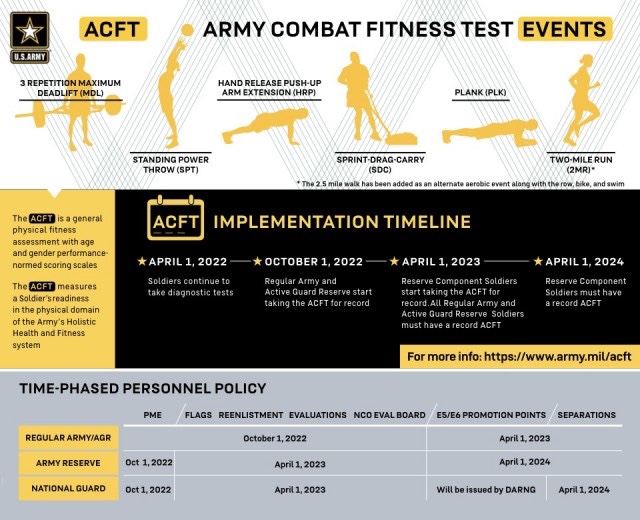
Beginning April 1, units will start diagnostic testing under the new structure. Record testing begins for Regular Army and Active Guard Reserve Soldiers on October 1, 2022, to allow Soldiers six-months to train. Also on October 1, a passing ACFT score will be used for retention, graduation of initial military training, professional military education, and evaluation reports for Regular Army and Active Guard Reserve Soldiers. Implementation of separation actions may begin in April 2023 for Regular Army and Active Guard Reserve Soldiers.
The Army also approved similar, but longer, timelines for Army Reserve and Army National Guard Soldiers, with April 2023 marking the start point for most personnel policies, and the implementation of separation actions beginning in April 2024.
“During this transition, we want to make sure all Soldiers have the proper time to succeed,” Grinston explained. “Put the test on the calendar and make sure your Soldiers have a solid training plan.”
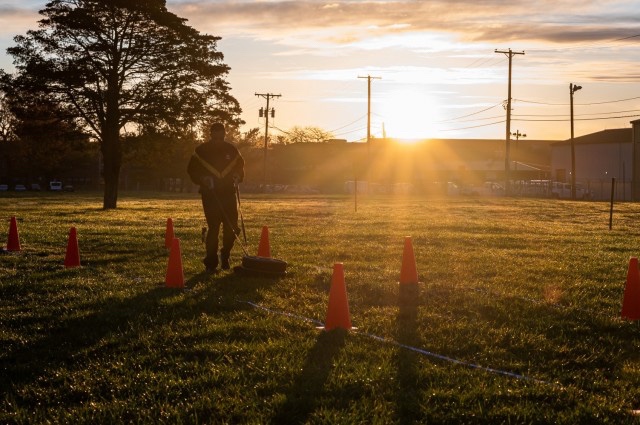
Grinston said while Regular Army Soldiers can be flagged beginning October 1, 2022 for failing the ACFT, no Regular Army Soldier will be separated solely for ACFT failure until April 2023.
The policy also directed a change to extend retesting periods from 90 days under the APFT to 180 days for Regular Army and Active Guard Reserve Soldiers, and 240 days for Reserve Soldiers for the ACFT. Grinston noted that the extended reconditioning timelines will guarantee that Soldiers who are willing to put in the time and training are provided an opportunity to pass the test.
Chain Teach throughout the Force
To help inform the force of all the policies and procedures of the test, the Sergeant Major of the Army is initiating a chain teach throughout the force – and personally gave Army Command, Army Service Component Command, and direct reporting unit command sergeants major a class on changes to the ACFT.
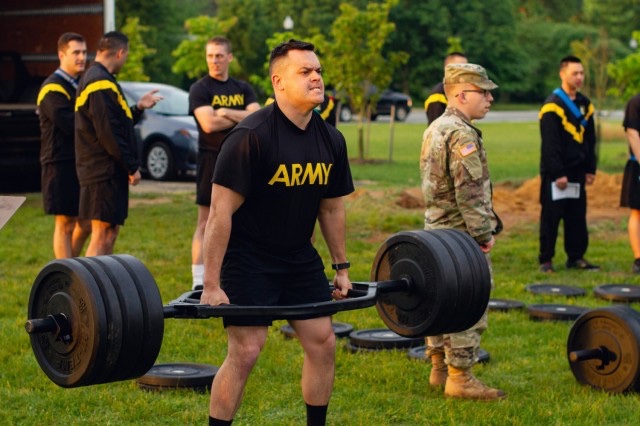
“They will turn around and give that class to the NCOs who report to them as well as the [command sergeants major] for their subordinate units,” Grinston said.
The chain teach will continue throughout the Army to ensure all noncommissioned officers and Soldiers are directly informed of the policy.
“This is an opportunity for leaders to get engaged and understand their Soldiers’ questions and concerns about the test,” Grinston said. “Know where they are struggling and develop a plan to help them succeed. Leaders need to address more than just physical training and focus on the Soldier’s overall fitness.”
To ensure Soldiers throughout the Total Army have comparable training opportunities, the Army procured and distributed more than 40,000 sets of equipment, 60% of which were designated for Soldiers in the Army Reserve and National Guard.
Grinston encouraged Leaders to use their equipment for physical readiness training, including on drill weekends for the Reserve Component, to help Soldiers familiarize themselves with the events before testing.
There are also a number of resources available on the ACFT website to help Soldiers train, including workout program examples and videos of exercises – many of which require no equipment.
Holistic Approach
Army leaders expect units to incorporate principles of all the Holistic Health and Fitness (H2F) System domains into their training. In addition to the physical domain, Leaders should include proper nutrition, sleep, and spiritual and mental fitness to improve overall Soldier readiness. Unit master fitness trainers are the subject-matter experts and are trained to advise in all domains of fitness.
“H2F is an incredible system that looks at training in ways the Army has never done before,” said Brig. Gen. John Kline, commanding general of the Center for Initial Military Training – the Army’s lead proponent for the H2F system.
“Incorporating things like mindfulness training, proper nutrition counseling, and better sleep techniques are proven methods to improve mental and physical readiness,” Kline said.
“If you really want to improve your ACFT score,” Grinston agreed, “start with those other four domains of fitness.”
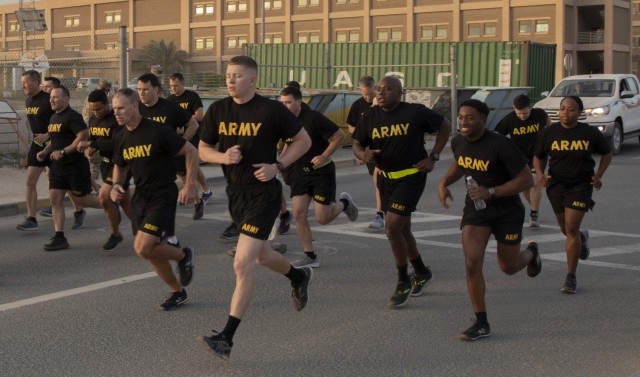
For the full details on the implementation of the ACFT, visit www.army.mil/acft.
By SFC Will Reinier


Now we have a test that is longer, and brings all of the problems of the APFT (gender preference for females, and favoring old people) into the new.
Disgusting. Army equipment isn’t getting lighter, but we will now continue to favor weaker and older soldiers.
Older Soldiers is where the experience is. You can always produce new Soldiers, but you can’t train experience.
It wont favor weaker and older Soldiers. It will not punish them for biological differences or injuries and age. Wait until you get older. Try and understand the bigger picture. It normalizes the standard so promotions and assignments and comparisons are fair. Do you want to follow a leader who is scoring a barely passing score because he was deployed 5 times, injured 10? No, so, this normalizes it. Is a Soldier fresh out out OCS or OSUT a better soldier because he/she scored better than the beaten up multiple deployed E7? No, this normalizes that
Let me grab my canteen and take a knee. I feel like these comments are going to get spicy!
Jokes aside is this really where we are for a 60pt Go? I know that won’t get it done for most units, but still….10 HRP?
This has been a massive PR loss for the Army and another massive money sink. Repeating the mistakes of UCP, the A365/IPPS-A rollout, etc. Honestly if Afghanistan wasn’t a big enough example, the past 20 years have shown that you cannot “fail” at the high end of military command. Multiple CSA’s and SMA’s have personally vouched for and defended this test and it is being touted as a win that all of the claims about the ACFT (COMBAT fitness test) have proven to be false if not downright lies. If you tell congress you are making a science based, age and gender neutral, combat focused fitness test and it turns out that it was not science based, cannot be made age or gender neutral, and does not correlated to combat demands, HOW HAVE YOU NOT FAILED AS A LEADER?
Add ArmyIgnitED to that list of mistakes too
The Army will keep scaling this back until we are left with:
Hand-release pushups
Plank
2 mile run.
With scoring broken down by gender/age bracket.
Should we call it ACFT 4.0 or APFT 2.0?
RIP Leg Tuck
2016-2022
I came looking for the final standard they decided on for it. Oh well.
Blessed be The Leg Tuck.
Sh*t, maybe it is time to just have WW3…
“and the addition of the 2.5-mile walk as an alternate aerobic event.”
Did they mean “run” or is that as dumb as it sounds?
Some folks can’t run. They offer alternative aerobic events. There’s a 1 km swim, 2.5 mile walk, 12 km bike and 5 km row.
Thanks for the clarification, other options at least make some form of sense, but once they say walk with score, I can’t help but thinking of the speed walking episode of Malcom in the Middle heh
I’ve never done the walk, but it looks like it sucks and I wouldn’t want to do it.
Maybe I’m missing something that is obvious to everyone else, but when I hear walk it just makes it sound like one gets done at a leisurely pace and “surviving” a 2.5 mile walk isn’t much of an accomplishment/standard. If wanting a better time then people inevitably end up jogging or running.
Is there some modifier like like walking with 100 pounds uphill?
So if folks can’t run, what are the alternate events for the Sprint-Drag-Carry?
There better be a good reason you’re still on active duty and can’t run, and don’t tell me it’s because you’re in an MOS that has you riding a desk.
We need better combat readiness, and this does the opposite. We just spent years slogging across Middle Eastern deserts, the mountains of Asia and obviously didn’t learn a damn thing.
Army life is rough on your body. Simple stuff like sitting in a gunner’s seat with body armor or dismounted patrolling will wreck your body. Add this to the fact that mobility training is a foreign concept to almost everyone outside the sof community and you end up with alot of guys and gals that lose their ability to run or do other forms of exercise without injury. Want to give a shout out to the ready state by Kelly starett I believe it’s the best program for military athletes who want to stay injury free or recover performance after injury.
I should have clarified my comment to read a good reason might be wrecking your body because you’ve carried one too many heavy loads up a mountain. In that situation and the others you’ve mentioned I can see the change. I just hope it doesn’t become and out for Fatty, and every other slug that can’t make the standard.
Why is running a requirement to be able to fly a helicopter?
When I got in the Vietnam era helicopter pilots were at the tail end of their career. They might have been old and crusty, but damn they knew how to fly!
I had a battalion commander who once said that he didn’t think the APFT was a good test of combat fitness but he never met a soldier who maxed the APFT who wasn’t in acceptable combat fitness condition (line infantry, not SOF). The beauty of the APFT was no equipment required. You could do it every week if you wanted. This new one seems to be quite the ordeal.
Ordeal is the right word. Thousands of dollars of equipment for FOUR lanes to push a unit through, assuming it even receives all the pieces. Then add on the fact that M-Day Soldiers of the reserve component have to waste time setting up, taking inventory, and storing equipment. What a waste of money and limited time.
I think the army has bottled this in so much that soldiers are required to fight in battle order. The least they could have done with this is require the solders to sit the tests wearing uniform and boots. Running the 2M in PT shorts and trainers is one thing; doing it in kit and boots is something else. I believe the Brits have finally got this right. Their tests are required to be done in kit, helmet, body armour, belt kit, weapon and boots. This is much more realistic, not to say tougher.
Having just gotten out, I can say I think this is the right move for the Army. I think the leg tuck was a great idea but it just didn’t pan out. Also the plank is harder in my mind and it requires less equipment. The point of the leg tuck was to test abdominal muscles but it did more than what it was intended so they replaced it.
To be fair, female bodies are different than males. I’ve seen females max the APFT and not be able to perform the leg tuck due to body proportions. I don’t think it’s fair to create a event that is scientifically unfair to a gender that we need in the military.
My question is, now that women are in combat MOSs (nearly 10K of them) and now that transgender soldiers are allowed to change their gender in DEERS…how will the ACFT 2.0 gender non-neutral test work?
Seems like weaker female 11B will score just as good or higher on paper then their male peers. Given that ACFT score is often factored into promotion waivers for E1 through E4 and is a sizable percentage of promotion points for E4 to E5, it will be tilting the playing field in women getting promoted over stronger and fitter men.
Additionally it stands to reason that Male to Female TG soldiers will have an even greater advantage as they have the muscle mass and skeleton of a man and will be rated on the lower female standard. The structural advantages they will receive will be off the charts. I predict lots of TG male to female soldiers winning PT Awards in BCT and AIT.
Seems like “The Big Guy” is putting his thumb on the scale to help a preferred class of soldier over everyone else. The obvious double standard will undermine good order and discipline and physical readiness of the force.
As an active duty SM, and because female GBs are being pushed into our SOF ranks, I am saddened that the Army is keeping gender bias in its ACFT scores. If men and women are “the same” now, please integrate combat MOSs by keeping the standards the same for any gender. Bullets dont care if you’re a man or woman…
The thing is, when readiness numbers in are garbage, USR is make believe.
Flat out: American Soldiers are poorly trained. Many great ideas, great training strategies, poorly understood, implemented, & executed. The Army culture caters to the lowest performing percentile – the parasites & protected “persons” among the serving.
The day will come when those readiness numbers will meet the ultimate test.
4 Generations of CIBs ends with me. Our line will no longer contribute bodies to this ishtshow.
Spent the last 40 years talking about a new PT test along with hundreds of millions of dollars to make a “better-fit Soldier”, yet we have spent zilch on mental health counseling while Soldiers take their own lives at an ever-increasing pace.